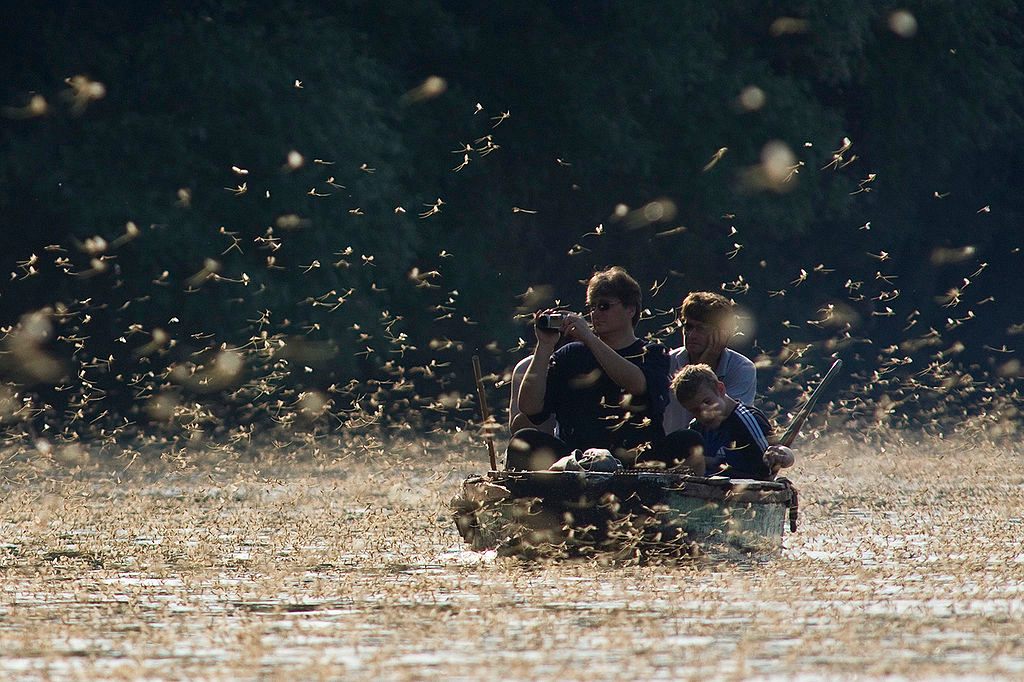The Living Nightmare of the Mayfly Invasion
 Mayflies emerge from the lake. (Photo: Kovacs.szilard/WikiCommons CC BY-SA 3.0)
Mayflies emerge from the lake. (Photo: Kovacs.szilard/WikiCommons CC BY-SA 3.0)
On June 15th, central Pennsylvania was bombarded by a plague of biblical proportions. Emerging from the Susquehanna river at night, adult mayflies literally swarmed the roads outside of the towns of Columbia, Wrightsville, and Lancaster. Attracted to the bright streetlights on bridges, the insects perished en masse —creating a two-inch layer of dead bugs.
The bugs wreaked havoc. Police reported that three motorcycle crashes resulted from the slippery conditions created by the decaying mayflies, along with numerous road and bridge closures. They even had to employ snowplows to clear the bridges.

Columbia, PA borough fire chief Scott Ryno told the Lancaster Online:
“It was like a blizzard in June, except instead of snow, it was mayflies… Visibility was zero for maybe a quarter mile across the bridge. They were getting in our mouth. We had to close our eyes. We had to swat them away. Even when we got back, it felt like bugs were crawling on you.”
A fluke event? Surprisingly, not really. Every year in June and July along rivers in the American Midwest and Southeast, thousands upon thousands of mayflies emerge from bodies of freshwater for a singular purpose: The continuation of their species. These ungainly creatures (basically just flying sexual organs) enjoy a singular night in their adult form dedicated to frenzied copulation, after which they lay eggs and die. And often, humans get to witness a night (or day) where flies fall from the sky like rain.
Spending the majority of their lives underwater, mayflies hatch as larvae, and slowly undergo a transition to their adult form—a process called incomplete metamorphosis. These little guys spend up to four years (dependent on the species) foraging on algae, plants, and organic matter on riverbeds.
Though unseemly, these larvae are crucial prey for a variety of freshwater fish. Migratory birds, especially those that feed on the mayfly nymphs while on their way to northerly breeding grounds, rely on the underwater critters to survive.
So you can probably live with mayfly larvae in the water. What probably makes you more uncomfortable, is this:
Swarming Mayflies cause the closure of the 462 bridge between Columbia & Wrightsville late Saturday @LancasterOnline pic.twitter.com/UKbAgMuXdZ
— Blaine Shahan (@BlaineShahanLNP) June 14, 2015
While this looks revolting, it is actually a positive ecological signal for the Susquehanna River. Mayfly larvae have delicate external gill structures, which causes them to die in polluted streams. Mayflies only hatch in mass proportions when the water is extremely clean, and they are used by ecologists as a key indicator species of the health of freshwater ecosystems.
While mayflies occur all over the world, it’s the particular species that reside in the American Midwest and Southeast that undergo a synchronized transition to their adult form, forming the massive hordes we all know and love.
 Adult mayfly close-up. (Photo: Mario Quevedo/Flickr)
Adult mayfly close-up. (Photo: Mario Quevedo/Flickr)
Because adult mayflies only survive for a few hours at a time (some species don’t even have working mouths), they must use the cover of darkness to avoid predators, and successfully mate before they expire. The swarms are an evolutionary advantage, ensuring that enough mayflies will successfully start a new generation. Their mass deaths are a boon for local predators - who clearly don’t mind the pervasive smell of dead fish emitted from the decaying piles.
The decaying mayflies piled on the sidewalk of the Veterans Memorial Bridge smell pretty bad. @LancasterOnline pic.twitter.com/EIRgh0x5Ml
— Blaine Shahan (@BlaineShahanLNP) June 15, 2015
Some swarms are so huge, they actually show up on weather radar, like this one from La Crosse, WI in July of 2014:
 Radar map of mayfly swarm. (Courtesy of AccuWeather)
Radar map of mayfly swarm. (Courtesy of AccuWeather)
As renewed efforts to clean our waterways continue, expect to see more grotesque swarms of mayflies. So if you live near a river or lake in the Midwest, don’t be afraid if you wake up and your car is crawling with flies.
In fact, you should be happy. This means that your local waterway is a healthy, thriving ecosystem that will continue to produce glorious swarms of insects, year after year. It seems that there’s an upside to having your day interrupted by a storm of flies.
To see more about the lifecycle of mayflies, check out this short video from National Geographic:



Follow us on Twitter to get the latest on the world's hidden wonders.
Like us on Facebook to get the latest on the world's hidden wonders.
Follow us on Twitter Like us on Facebook